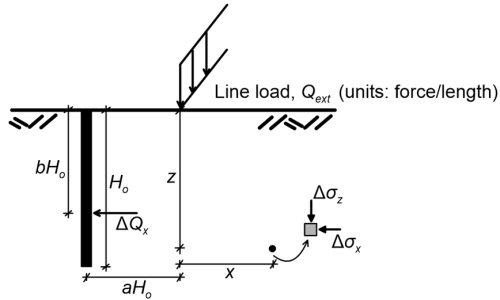3.3 Stresses in the soil due to a line load
Loading transferred to the soil from e.g., a rail track of limited width (Figure 3.6) can be modelled as an “infinitely long” line load acting on the surface of a homogeneous elastic half-space. As plane-strain symmetry conditions apply, additional soil stresses due to the application of a line load can be calculated as:

(3.5) ![]()
(3.6) ![]()
(3.7) ![]()
The stress increment components and the vertical z and horizontal x distance from the line load considered in Eqs. 3.5 to 3.7 are defined in Figure 3.6.
In the special case where the line load is acting near the crest of a retaining wall, the horizontal stress distribution along the wall height can be determined as function of the height of the wall Ho (Figure 3.6):
(3.8) ![]()
and the resultant horizontal force per running meter of the wall is equal to (Figure 3.6):
(3.9) ![]()
Note that Eq. 3.8 yields identical results to Eq. 3.5, the only difference between these expressions is that in Eq. 3.8 the coordinates x and z as expressed as function of Ho.

